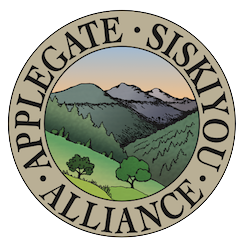
The Lower Applegate, between Murphy and Wilderville, is known for its agricultural flats, not its wilderness habitat. As it blends into the outskirts of Grants Pass, the area is the most heavily populated portion of the Applegate Valley; however, two significant wildlands tucked into the surrounding mountains provide important habitat for wildlife. Although not remote, the wildlands are obscure and seldom visited. They support interesting serpentine habitat, clear flowing streams and dense old forests. No recreational trails dissect these wildlands and access into their interior requires extremely difficult off-trail hiking. Those who venture into the center of these wildlands will be rewarded with solitude, spectacular forests, abundant wildflowers and long vistas across the mountains and valleys of southwestern Oregon. These last wild habitats in the Lower Applegate support a unique piece of the Applegate Valley’s biodiversity and natural heritage. They should be protected for future generations as an important refuge for wild nature.
Slate Creek Roadless Area

The unprotected Slate Creek Roadless Area is located at the headwaters of Slate Creek on the Rogue River-Siskiyou National Forest. The area is relatively small, at roughly 3,500 acres, but contains unusual serpentine habitat, completely unique to the Applegate River watershed. Embedded within the roadless area is the 386-acre Cedar Log Flat Research Natural Area, which protects the only population of the insectivorous cobra lily (Darlingtonia californica) in the Applegate River basin, and numerous rare plant populations including Waldo buckwheat, which is otherwise found only in the Illinois River Valley.

Slate Creek is the first major tributary of the Applegate River. It supports runs of chinook salmon, steelhead and some of the Applegate River’s most abundant runs of coho salmon. The stream flows along Highway 199 through Wonder and Wilderville before dumping into the Applegate River, west of Grants Pass.

The area receives roughly twice as much rainfall as the driest portions of the Applegate Valley and supports abundant winter fog. The weather, the vegetation and the unique soils in the area are very similar to portions of the Illinois Valley with its endemic serpentine flora. Serpentine soils contain significant concentrations of various heavy metals and lack basic nutrients generally associated with plant growth. They are essentially toxic to plant life, but unique plant communities have evolved to thrive on these nutrient limited soils. The unusual soils support barren red rock openings, carpeted in low chaparral, sparse grass, abundant wildflowers and twisted Jeffrey pine. Majestic Port Orford-cedar, bay laurel, western azalea, and alder dominate the stream corridors, and boggy wetlands flow down serpentine slopes and into grassy clearings lined in cobra lily.
Round Top Mountain Roadless Area

The Round Top Mountain Roadless Area is located on the high, rocky ridgeline dividing the Illinois Valley from the Lower Applegate Valley. Portions of the area drain into the Deer Creek watershed near Selma, while the northernmost portions of the wildland drain into Jackson Creek, Murphy Creek, and Panther Creek in the Applegate River watershed.
The wildland is centered around 4,760′ Round Top Mountain and the flanks of nearby Manzanita Lookout. From 1959 to 2010 the Oregon Department of Forestry maintained a fire lookout at a broad summit west of Round Top Mountain, the site was known as Manzanita Lookout. After being condemned for safety concerns, the lookout tower was burned to the ground by ODF officials in 2010.

The area is a patchwork of rock outcrops, serpentine barrens, and mixed conifer forests. Located in the western, more moist portion of the Applegate Valley, the area receives abundant rain and winter fog. On productive soils old-growth forests of Douglas fir, ponderosa pine, sugar pine, white fir, incense cedar, live oak and madrone grow in contiguous unlogged forest habitats. The vast old-growth canopy is occasionally broken by serpentine outcrops, open Jeffrey pine savanna, young forests regenerating from historic wildfires, and mixed hardwood groves.

A portion of the intact habitat was protected in the BLM’s 2016 Resource Management Plan as the Round Top Mountain Lands with Wilderness Characteristics (LWC). This 5,295-acre LWC protects the core of the area, but significant unroaded habitats at the margins of the LWC are currently unprotected.
Bolt Mountain

Bolt Mountain is not quite a wildland, but it makes an interesting and beautiful hike exploring the serpentine habitats of the Lower Applegate Valley. The low, rounded butte is a unique and isolated hump of serpentine rising 1,258’ from the valley floor above Jerome Prairie and the Applegate River near Fish Hatchery Park. A 3.3 mile trail beginning at Fish Hatchery Park climbs through beautiful Jeffrey pine woodlands with spectacular views and incredible spring floral displays. The trail climbs to the 2,227’ summit and provides an accessible hike in the serpentine habitats of the Lower Applegate.

Mark your calendars! Applegate Neighborhood Network will be leading a hike, along with the Siskiyou Chapter Native Plant Society of Oregon, to the Cedar Log Flat Research Natural Area on May 11th. For more information: https://www.facebook.com/events/304339286907833/
To RSVP email luke@applegatesiskiyoualliance.org
A version of this article was originally printed in the Spring 2019 edition of the Applegater Newsmagazine.

